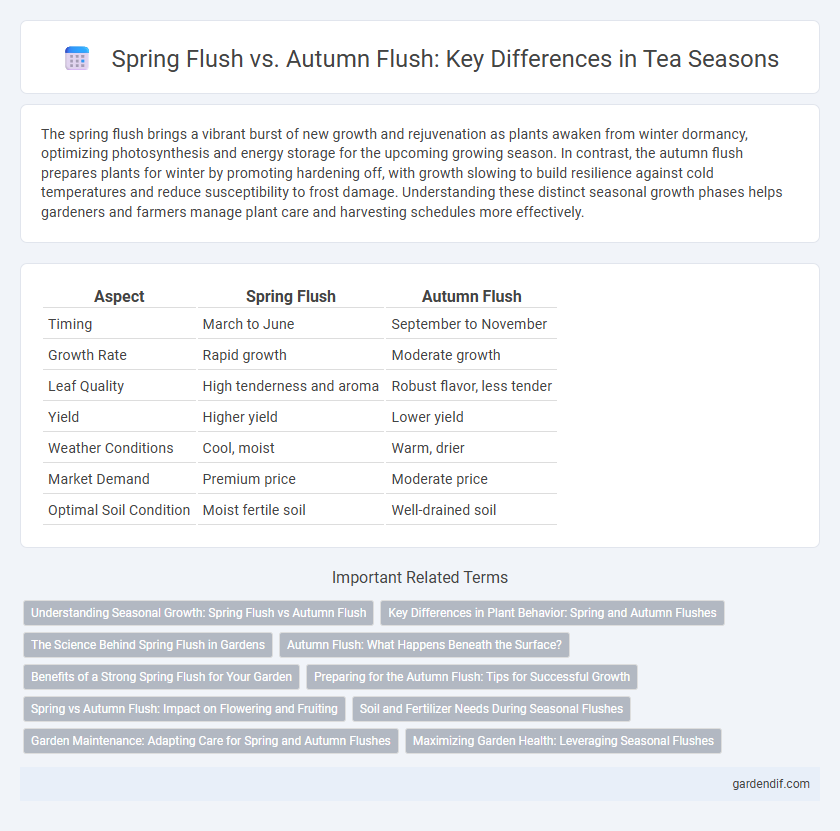
Spring flush vs Autumn flush Illustration
The spring flush brings a vibrant burst of new growth and rejuvenation as plants awaken from winter dormancy, optimizing photosynthesis and energy storage for the upcoming growing season. In contrast, the autumn flush prepares plants for winter by promoting hardening off, with growth slowing to build resilience against cold temperatures and reduce susceptibility to frost damage. Understanding these distinct seasonal growth phases helps gardeners and farmers manage plant care and harvesting schedules more effectively.
Table of Comparison
| Aspect | Spring Flush | Autumn Flush |
|---|---|---|
| Timing | March to June | September to November |
| Growth Rate | Rapid growth | Moderate growth |
| Leaf Quality | High tenderness and aroma | Robust flavor, less tender |
| Yield | Higher yield | Lower yield |
| Weather Conditions | Cool, moist | Warm, drier |
| Market Demand | Premium price | Moderate price |
| Optimal Soil Condition | Moist fertile soil | Well-drained soil |
Understanding Seasonal Growth: Spring Flush vs Autumn Flush
Spring flush involves vigorous growth as plants emerge from dormancy with increased photosynthesis and nutrient uptake, typically resulting in rapid leaf expansion and shoot development. Autumn flush occurs later in the season, often producing a second wave of growth that is less intense but critical for hardening off and storing carbohydrates for overwintering. Differences in temperature, daylight, and water availability drive the variations between spring and autumn flush, influencing plant health and overall productivity.
Key Differences in Plant Behavior: Spring and Autumn Flushes
Spring flush triggers rapid cell division and vigorous shoot growth driven by increased daylight and rising temperatures, promoting active photosynthesis and nutrient uptake. Autumn flush is characterized by slowed growth and preparation for dormancy, with plants reallocating resources to roots and storage organs while reducing metabolic activity. These seasonal variations reflect adaptive strategies optimizing survival and growth efficiency in response to environmental cues.
The Science Behind Spring Flush in Gardens
Spring flush in gardens occurs as rising temperatures and increased daylight stimulate rapid growth in plants, driven by hormonal changes such as elevated auxin and cytokinin levels. This phase triggers robust cell division and elongation, resulting in fresh leaves, shoots, and flowers that enhance photosynthesis and energy production for the growing season. Contrasting with the autumn flush, which is often a response to cooler temperatures and preparation for dormancy, the spring flush represents a vital rejuvenation period investing in biomass accumulation and reproductive success.
Autumn Flush: What Happens Beneath the Surface?
During the autumn flush, tea plants experience significant root activity as cooler temperatures stimulate nutrient absorption and storage for winter dormancy. The leaves produced tend to have higher concentrations of amino acids and theanine, enhancing the tea's flavor and sweetness. Beneath the surface, soil microorganisms increase in activity, breaking down organic matter and improving soil fertility, which supports healthier tea growth in the following spring flush.
Benefits of a Strong Spring Flush for Your Garden
A strong spring flush promotes vigorous new growth, enhancing nutrient uptake and boosting overall plant health. It supports higher photosynthetic activity, which improves flowering and fruiting potential throughout the growing season. Early development during spring flush also strengthens root systems, making plants more resilient to pests and environmental stressors.
Preparing for the Autumn Flush: Tips for Successful Growth
Effective preparation for the autumn flush involves optimizing soil nutrients and maintaining consistent moisture levels to support vigorous new growth. Pruning dead or weak branches before the cooler months encourages healthy leaf development and maximizes photosynthesis. Applying balanced fertilizers rich in nitrogen and potassium enhances root health and resilience against seasonal stresses during the autumn growth phase.
Spring vs Autumn Flush: Impact on Flowering and Fruiting
Spring flush promotes vigorous vegetative growth, which is crucial for providing the structural foundation for flowering and fruiting. In contrast, autumn flush tends to produce less robust shoots, often leading to reduced flower bud differentiation and lower fruit yield in the following season. Understanding the physiological differences between spring and autumn flushes helps optimize crop management practices to enhance flowering intensity and fruit quality.
Soil and Fertilizer Needs During Seasonal Flushes
Spring flush requires soils to be rich in nitrogen as plant growth accelerates, demanding ample fertilization to support new shoots and leaves. Autumn flush benefits from balanced fertilizer applications emphasizing potassium and phosphorus to strengthen root systems and enhance plant resilience before dormancy. Efficient nutrient management aligned with seasonal flushes optimizes soil health and plant development.
Garden Maintenance: Adapting Care for Spring and Autumn Flushes
Spring flush demands heightened attention to pruning and fertilization, promoting vigorous new growth and vibrant blooms. In contrast, autumn flush requires careful preparation for dormancy, emphasizing soil enrichment and mulching to protect roots from colder temperatures. Adjusting watering schedules and pest management according to seasonal growth patterns ensures optimal plant health throughout both flushes.
Maximizing Garden Health: Leveraging Seasonal Flushes
Spring flush promotes vigorous new growth driven by increased daylight and warmer temperatures, enabling plants to strengthen their root systems and recover from winter dormancy. Autumn flush, triggered by cooler temperatures and shorter days, supports the development of hardier tissues and nutrient storage essential for winter resilience. Maximizing garden health involves strategically timing fertilization and pruning to coincide with these flushes, optimizing nutrient uptake and plant vitality throughout the growing season.
Spring flush vs Autumn flush Infographic

 gardendif.com
gardendif.com